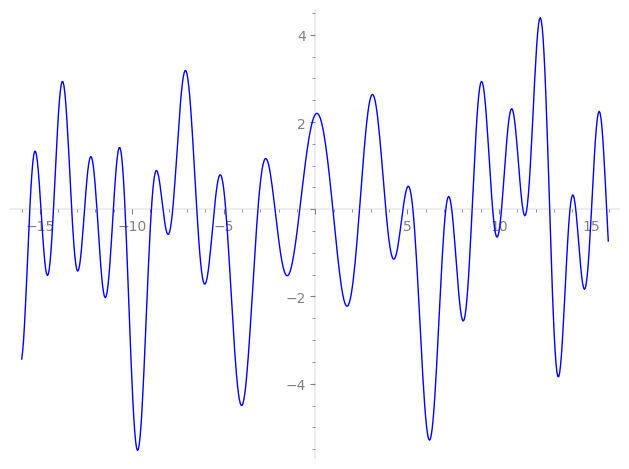| L(s) = 1 | − 3i·3-s + (−0.273 − 0.273i)5-s + (21.0 + 21.0i)7-s − 9·9-s + (−25.8 − 25.8i)11-s + (−15.7 − 44.1i)13-s + (−0.820 + 0.820i)15-s + 111. i·17-s + (64.0 − 64.0i)19-s + (63.0 − 63.0i)21-s + 92.7·23-s − 124. i·25-s + 27i·27-s + 254.·29-s + (−173. + 173. i)31-s + ⋯ |
| L(s) = 1 | − 0.577i·3-s + (−0.0244 − 0.0244i)5-s + (1.13 + 1.13i)7-s − 0.333·9-s + (−0.709 − 0.709i)11-s + (−0.335 − 0.941i)13-s + (−0.0141 + 0.0141i)15-s + 1.59i·17-s + (0.773 − 0.773i)19-s + (0.655 − 0.655i)21-s + 0.840·23-s − 0.998i·25-s + 0.192i·27-s + 1.63·29-s + (−1.00 + 1.00i)31-s + ⋯ |
\[\begin{aligned}\Lambda(s)=\mathstrut & 624 ^{s/2} \, \Gamma_{\C}(s) \, L(s)\cr =\mathstrut & (0.889 + 0.457i)\, \overline{\Lambda}(4-s) \end{aligned}\]
\[\begin{aligned}\Lambda(s)=\mathstrut & 624 ^{s/2} \, \Gamma_{\C}(s+3/2) \, L(s)\cr =\mathstrut & (0.889 + 0.457i)\, \overline{\Lambda}(1-s) \end{aligned}\]
Particular Values
| \(L(2)\) |
\(\approx\) |
\(2.180853296\) |
| \(L(\frac12)\) |
\(\approx\) |
\(2.180853296\) |
| \(L(\frac{5}{2})\) |
|
not available |
| \(L(1)\) |
|
not available |
\(L(s) = \displaystyle \prod_{p} F_p(p^{-s})^{-1} \)
| $p$ | $F_p(T)$ |
|---|
| bad | 2 | \( 1 \) |
| 3 | \( 1 + 3iT \) |
| 13 | \( 1 + (15.7 + 44.1i)T \) |
| good | 5 | \( 1 + (0.273 + 0.273i)T + 125iT^{2} \) |
| 7 | \( 1 + (-21.0 - 21.0i)T + 343iT^{2} \) |
| 11 | \( 1 + (25.8 + 25.8i)T + 1.33e3iT^{2} \) |
| 17 | \( 1 - 111. iT - 4.91e3T^{2} \) |
| 19 | \( 1 + (-64.0 + 64.0i)T - 6.85e3iT^{2} \) |
| 23 | \( 1 - 92.7T + 1.21e4T^{2} \) |
| 29 | \( 1 - 254.T + 2.43e4T^{2} \) |
| 31 | \( 1 + (173. - 173. i)T - 2.97e4iT^{2} \) |
| 37 | \( 1 + (-90.5 + 90.5i)T - 5.06e4iT^{2} \) |
| 41 | \( 1 + (-235. - 235. i)T + 6.89e4iT^{2} \) |
| 43 | \( 1 + 291.T + 7.95e4T^{2} \) |
| 47 | \( 1 + (35.6 + 35.6i)T + 1.03e5iT^{2} \) |
| 53 | \( 1 - 655.T + 1.48e5T^{2} \) |
| 59 | \( 1 + (-64.7 - 64.7i)T + 2.05e5iT^{2} \) |
| 61 | \( 1 - 243.T + 2.26e5T^{2} \) |
| 67 | \( 1 + (-286. + 286. i)T - 3.00e5iT^{2} \) |
| 71 | \( 1 + (-707. + 707. i)T - 3.57e5iT^{2} \) |
| 73 | \( 1 + (-530. + 530. i)T - 3.89e5iT^{2} \) |
| 79 | \( 1 + 1.26e3iT - 4.93e5T^{2} \) |
| 83 | \( 1 + (358. - 358. i)T - 5.71e5iT^{2} \) |
| 89 | \( 1 + (374. - 374. i)T - 7.04e5iT^{2} \) |
| 97 | \( 1 + (-759. - 759. i)T + 9.12e5iT^{2} \) |
| show more | |
| show less | |
\(L(s) = \displaystyle\prod_p \ \prod_{j=1}^{2} (1 - \alpha_{j,p}\, p^{-s})^{-1}\)
Imaginary part of the first few zeros on the critical line
−10.37134219217049408350634122116, −8.936633622220134962174887290402, −8.305414172509158477873128119802, −7.77450503518195488013155078274, −6.46445439077010143176837256276, −5.50836452341453237133725853545, −4.88867891377028305634625463675, −3.13385323436241087870735425612, −2.20396126863044520937948448470, −0.853644606822210866322163527979,
0.948488008666383540174237599510, 2.40034125451160749353558428940, 3.83181850174264929038613325379, 4.76677109704469241552611477753, 5.30658628766744226490781728173, 7.10024944141400274502592732915, 7.42239041949324380236529553712, 8.533325717758367649071596926696, 9.653287816621695495033858257778, 10.13526502051881287500528393979

